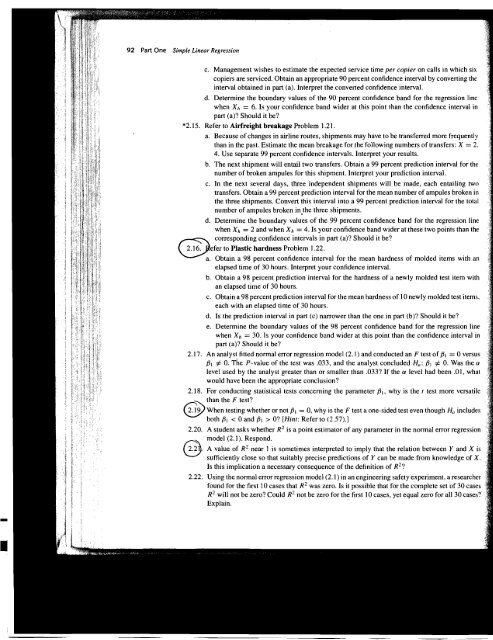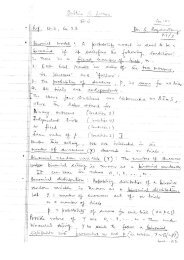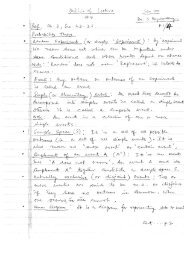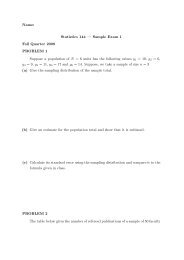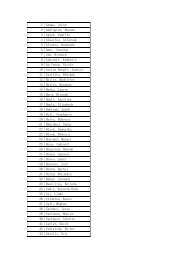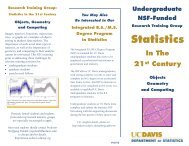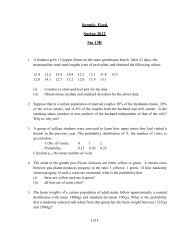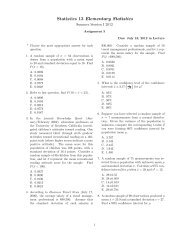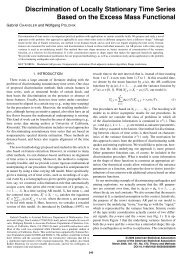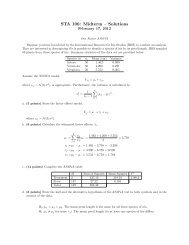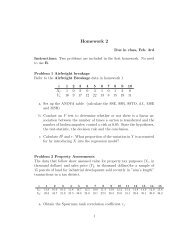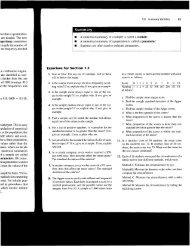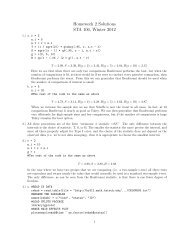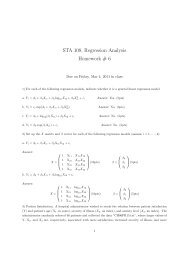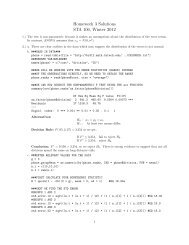HW2 - Statistics
HW2 - Statistics
HW2 - Statistics
Create successful ePaper yourself
Turn your PDF publications into a flip-book with our unique Google optimized e-Paper software.
92 Part One Simple Linear Regression<br />
c. Management wishes to estimate the expected service time per copier on calls in which six<br />
copiers are serviced. Obtain an appropriate 90 percent confidence interval by converting the<br />
interval obtained in part (a). lnterpret the converted confidence interval.<br />
d. Determine the boundary values of the 90 percent confidence band for the regression line<br />
when X,, = 6. Is your confidence band wider at this point than the confidence interval in<br />
part (a)? Should it be?<br />
*2.15. Refer to Airfreight breakage Problem I .21.<br />
a. Because of changes in airline routes, shipments may have to be transferred more frequently<br />
than in the past. Estimate the mean breakage for the following numbers of transfers: X = 2.<br />
4. Use separate 99 percent confidence intervals. Interpret your results.<br />
b. The next shipment will entail two transfers. Obtain a 99 percent prediction interval for the<br />
number of broken ampules for this shipment. lnterpret your prediction interval.<br />
c. In the next several days, thee independent sh~pments will be made, each entailing two<br />
transfers. Obtain a 99 percent prediction interval for the mean number of ampules broken in<br />
the three shipments. Convert this interval into a 99 percent prediction interval for the total<br />
number of ampules broken inJhe three shipments.<br />
d. Determine the boundary values of the 99 percent confidence band for the regression line<br />
when Xh = 2 and when Xh = 4. Is your confidence band wider at these two points than the<br />
elapsed time of 30 hours. Interpret your confidence interval.<br />
b. Obtain a 98 percent prediction interval for the hardness of a newly molded test item with<br />
an elapsed time of 30 hours.<br />
c. Obtain a 98 percent prediction interval for the mean hardness of 10 newly molded test items,<br />
each with an elapsed time of 30 hours.<br />
d. Is the prediction interval in part (c) narrower than the one in part (b)? Should it be?<br />
e. Determine the boundary values of the 98 percent confidence band for the regression line<br />
when Xh = 30. 1s your confidence band wider at this point than the confidence interval in<br />
part (a)? Should it be?<br />
2.17. An analyst fitted normal error regression model (2. I ) and conducted an F test of PI = 0 versus<br />
PI # 0. he P-value of the test was .033, and the analyst concluded H,: PI # 0. Was the a<br />
level used by the analyst greater than or smaller than .033? If the a level had been .Ol, whar<br />
would have been the avvrovriate conclusion?<br />
2.20. A student asks whether R' is a point estimator of any parameter in the normal error regression #<br />
2.22. Using the normal error regression model (2.1) in an engineering safety experiment, a researcher<br />
found for the first 10 cases that R' was zero. IS it possible that for the complete set of 30 cases<br />
R2 will not be zero? Could R2 not be zero for the first 10 cases, yet equal zero for all 30 cases?<br />
Explain.
3.23. Rel'er to Grade puint average Problem I. 19.<br />
a. Set up the ANOVA tahlc.<br />
Chapter 2 II!~~.I~,II
I<br />
I<br />
i<br />
148 Part One Simple Linear Regression<br />
d. Plot the residuals ei against Xi to ascertain whether any departures from regression<br />
model (2.1) are evident. What is your conclusion?<br />
e. Prepare a normal probability plot of the residuals. Also obtain the coefficient of correlation<br />
between the ordered residuals and their expected values under normality to ascertain whether<br />
the normality assumption is reasonable here. Use Table B.6 and a = .01. What do you<br />
conclude?<br />
f. Prepare a time plot of the residuals. What information is provided by your plot?<br />
g. Assume that (3.10) is applicable and conduct the Breusch-Pagan test to determine whether<br />
or not the error variance varies with the level of X. Use (Y = .lo. State the alternatives,<br />
decision rule, and conclusion. Does your conclusion support your preliminary findings in<br />
a. Obtain the residuals ei and prepare a box plot of the residuals. What information is provided<br />
by your plot?<br />
b. Plot the residuals ei against the fitted values pi to ascertain whether any departures from<br />
regression model (2.1) are evident. State your findings.<br />
c. Prepare a normal probability plot of the residuals. Also obtain the coefficient of correlation<br />
between the ordered residuals and their expected values under normality. Does the normality<br />
assumption appear to be reasonable here? Use Table B.6 and (Y = .05.<br />
*3.7. Refer to Muscle mass Problem 1.27.<br />
c. Plot the residuals e, against ?; and also against Xi on separate graphs to ascertain wh<br />
any departures from regression model (2.1) are evident. Do the two plots provide the<br />
information? State your conclusions.<br />
d. Prepare a normal probability plot of the residuals. Also obtain the coefficient of correla<br />
between the ordered residuals and their expected values under normality to ascertain whe<br />
or not the error variance varies with the level of X. Use (Y = .01. State the alte<br />
decision rule, and conclusion. Is your conclusion consistent with your preliminary<br />
in part (c)?<br />
3.8. Refer to Crime rate Problem 1.28.<br />
a. Prepare a stem-and-leaf plot for the percentage of individuals in the county having at 1<br />
a high school diploma Xi. What information does your plot provide?<br />
b. Obtain the residuals ei and prepare a box plot of the residuals. Does the distribution of<br />
residuals appear to be symmetrical?
150 Part One Simple Linear Regression<br />
*3.13. Refer to Copier maintenance Problem.-I .20.<br />
a. What are the alternative conclusions when testing for lack of fit of a linear regression<br />
function?<br />
b. Perform the test indicated in part (a). Control the risk of Type I error at .05. State the decision<br />
rule and conclusion.<br />
c. Does the test in part (b) detect other departures from regression model (2.1), such as lack<br />
of constant variance or lack of normality in the error terms? Could the results of the test of<br />
lack of fit be affected by such departures? Discuss.<br />
3.14. Refer to PIastic hardness Problem 1.22.<br />
a. Perform the F test to determine whether or not there is lack of fit of a linear regression<br />
function; use cr = .01. State the alternatives, decision rule, and conclusion.<br />
b. Is there any advantage of having an equal number of replications at each of the X levels? Is<br />
there any disadvantage? .<br />
c. Does the test in part (a) indicate what regression function is appropriate when it leads to the<br />
conclusion that the regression function is not linear? How would you proceed?<br />
3.15. Solution concentration. A chemist studied the concentration of a solution (Y) over time (X).<br />
Fifteen identical solutions were prepared. The 15 solutions were randomly divided into five<br />
sets of three, and the five sets were measured, respectively, after 1, 3, 5, 7, and 9 hours. The<br />
results follow.<br />
3 ... 13<br />
Yi: .07 .09 .08 ... 2.84 2.57 3.10<br />
a. Fit a linear regression function.<br />
b. Perform the F test to determine whether or not there is lack of fit of a linear regression<br />
function; use cr = .025. State the alternatives, decision rule, and conclusion.<br />
c. Does the test in part (b) indicate what regression function is appropriate when it leads to the<br />
conclusion that lack of fit of a linear regression function exists? Explain.<br />
3.1 6. Refer to Solution concentration Problem 3.15.<br />
a. Prepare a scatter plot of the data. What transformation of Y might you try, using the prototy<br />
patterns in Figure 3.15 to achieve constant variance and linearity?<br />
b. Use the Box-Cox procedure and standardization (3.36) to find an appropriate powe<br />
transformation. Evaluate SSE for ,I = -.2, -. 1,0, .I, .2. What transformation of Y i<br />
suggested?<br />
c. Use the transformation Y' = log,, Y and obtain the estimated linear regression function<br />
the transformed data.<br />
d. Plot the estimated regression line and the transformed data. Does the regression line ap<br />
to be a good fit to the transformed data?<br />
e. Obtain the residuals and plot them against the fitted values. Also prepare a normal probabi<br />
plot. What do your plots show?<br />
f. Express the estimated regression function in the original units.<br />
10 years ago. The data are as follows, where X is the year (coded) and Y is sales in thou
X,: 0 1 2 3 4 5 6 7 8 9<br />
Y,: 98 135 162 178 221 232 283 300 374 395<br />
:I. Prepare u scatter plot of the dnta. Does a linear relation appear adeq~~ate here?<br />
b. Use the Box-Cox procedul- *id standardiz:~tion (3.36) to tind an appropriate power trnnsforination<br />
of Y . Evaluate 4S.A or 1 = .3, .4. .5, .6. .7. What tfiuisformation of Y is suggested?<br />
c. Use the t~.anstor~nation Y' = fi and obtain the estimatetl linenrregrcssion function for the<br />
t~msformecl dam.<br />
d. Plot the estimated ~.cgression line and the transformed data. Does the regression line appear<br />
to be a good ti1 to the transformed data?<br />
e. Obtain the residu:lls:uid plot them against the titted values. Also prepare anormnl probability<br />
plot. What do yo~~r plots show'?<br />
t'. Express the estimated regression function in the original units.<br />
3.18. Production time. In ;I ~n;uiuh~cturing study, the procluction times l'or I I I recent production<br />
runs were obtained. The table below lists forcach run the production time in IIOLII.S (Y) ;111d [he<br />
production lot size (X ).<br />
E Y,: 14.28 8.80 12.49 .. 16.37 11.45 15.78<br />
X' = and obtain the estimated linear regression function for the (<br />
b. Use the trnnsfor~natio~i<br />
i . >..<br />
trnnsfor~ned data. z:~.<br />
c. Plot the estimated regression line and the transformed data. Does (lie regression line appear .<br />
to be a good tit to thc transformed data? %<br />
d. Obtain the residuals ;uid plot them against the fitted values. Also prepare :I normill probability<br />
plot. What do your plots show?<br />
e. Express the estimated regression function in the original ~~nits.<br />
I I I-I.~ 3.19. A student ti tted a linear regression filnction for a class assignment. The student plotted the<br />
residuals e, against Yj and found a positive relation. When the residuals were plotted against<br />
the fitted values p;. the student found no relation. How could this difference arise? Which is<br />
the more meaningful plot?<br />
i.20. If the error terlns in a regression model are independent N(0, a'), what can be said about the<br />
error terms after transformation X' = I / X is used? Is the situation the same after transformation<br />
Y' = I/ Y is used?<br />
;.?I. Derive the result in (3.29).<br />
.;<br />
j .;:<br />
I i<br />
i s i-~<br />
+ .>.<br />
: k::


